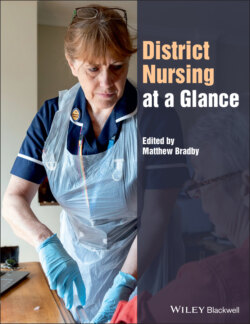Читать книгу District Nursing at a Glance - Matthew Bradby - Страница 13
1 The early history of district nursing
ОглавлениеMatthew Bradby
Figure 1.1 Cartoon of Queen’s Nurses in 1918.
Figure 1.2 Queen’s Nurse with a bicycle, c. 1900.
Figure 1.3 The celebrated midwife’s case, 1925.
Figure 1.4 Queen’s Nurses magazine advert, 1913.
Figure 1.5 Ground floor plan of a district nurse’s cottage, 1945.
Figure 1.6 Architect’s design for a district nurse’s cottage, 1945.
The district nursing movement started in Victorian England in the mid nineteenth century. The Victorian period was characterised by rapidly growing cities, where many people lived in extremely poor, cramped conditions. Malnutrition and unclean water supplies contributed to severe and regular outbreaks of contagious diseases, such as cholera, typhus and tuberculosis, which were the mass killers of the period. District nursing as an organised movement began when William Rathbone (1819–1902), a wealthy Liverpool merchant and philanthropist, employed a nurse, Mary Robinson, to care for his wife at home during her final illness. In May 1859 William Rathbone’s wife died, and he later wrote:
it occurred to me to engage Mrs. Robinson, her nurse, to go into one of the poorest districts of Liverpool and try, in nursing the poor, to relieve suffering and to teach them the rules of health and comfort. I furnished her with the medical comforts necessary, but after a month’s experience she came to me crying and said that she could not bear any longer the misery she saw. I asked her to continue the work until the end of her engagement with me (which was three months), and at the end of that time, she came back saying that the amount of misery she could relieve was so satisfactory that nothing would induce her to go back to private nursing, if I were willing to continue the work (Hardy, 1981).
William Rathbone decided to try to extend the service started with Mary Robinson, but soon found that there was a lack of trained nurses and that nurse training was disorganised and very variable in quality. In 1860, he wrote to Florence Nightingale, who advised him to create a nurse training school and home for nurses attached to the Liverpool Royal Infirmary and, with typical Victorian organisation and energy, this was built by May 1863.
For district nursing purposes, the city was divided into 18 ‘districts’, each made up of a group of parishes. Each district was under the charge of a Lady Superintendent drawn from a wealthy family. The system was non‐sectarian, though local ministers were encouraged to become involved. Liverpool was not alone in experiencing poverty and ill health and district nursing associations soon spread to other industrial cities – Manchester in 1864, Derby in 1865, Leicester in 1867, and London in 1868. The Victorian district nursing movement was characterised by several long running debates, which had their roots in views about social class and the role of working women. It took time, experimentation and organisation for the training of district nurses to become established. This coincided with an era of great advances in medical science and new ideas about the emancipation of women into paid occupations (Figures 1.1 and 1.2).
District nurses had to work hard to gain the confidence and trust of poorer families, for whom home nursing was a novelty: extended families were used to caring for their own relatives, but lacked the knowledge to do this effectively. Much attention was given to ‘putting the patient’s room in nursing order’, with reference to hygiene, ventilation and light. Nurses also educated people about the danger posed by flies and other pests. First aid and emergency interventions were also part of district nursing work. In the days before disposables, all equipment had to be sterilised in the home, either by boiling on a stove or heating in an oven. Used dressings were burned on the household fire (Figures 1.3 and 1.4).
The first nurses’ homes were rented flats or cottages, but by the 1930s dedicated nurses’ homes were being designed and built all over the country. These often included a ‘district room’ where a nurse could see patients, as well as stores for medical supplies and a garage (Figures 1.5 and 1.6). The earliest district nurses either walked to visit their patients or used a pony and trap. In the early twentieth century, bicycles were widely adopted, replaced in turn by motor scooters and small cars. In rural areas, where doctors were often remote, nurses were given additional responsibility. Many district nurses were trained as midwives and, after 1920, as health visitors too.
At least until the 1950s most district nurses were single women, living in nurses’ homes provided by local nursing associations. The nursing associations also employed the nurses in the days before the NHS; salaries were funded by donations and subscriptions. Nurses often had to collect fees from their patients, something that many nurses found very uncomfortable. From 1948, district nurses were employed first by local authorities and then by community healthcare organisations that have continued to evolve as part of the NHS ever since.
Post‐1948, in the early years of the NHS, much district nursing work involved combating infectious diseases such as tuberculosis, as well as caring for people with diabetes, cancer, bronchitis, or mental illness, and people who were disabled through accident or other cause. End‐of‐life care and wound care was very important, as was the coordination of other services. Modern district nursing has continued to evolve to meet the needs of people in their own homes, leading and coordinating the work of the multidisciplinary team. Today, as specialist practitioners, district nurses play a vital role to play in enabling people to live in greater comfort in their own homes, preventing unnecessary suffering and distress and promoting independence.
